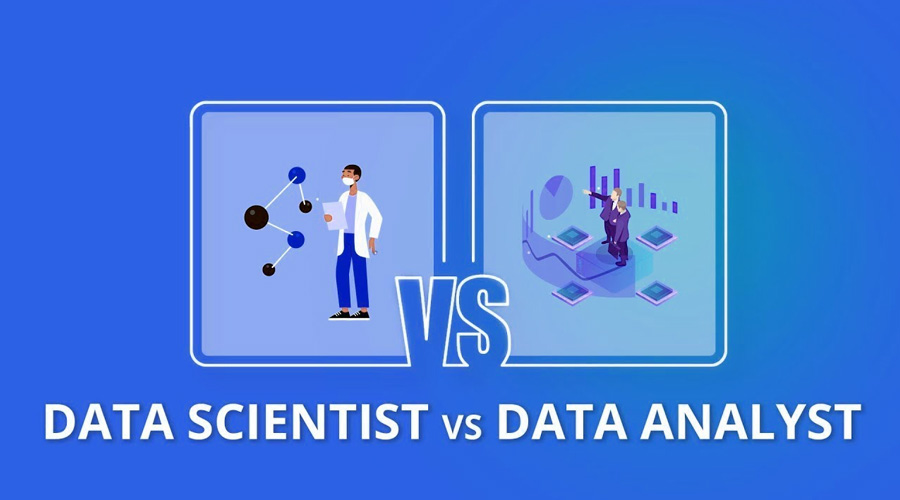The ever-changing world of information technology (IT) has brought us new innovations and ways of doing things and a host of new terms, phrases, and acronyms for us to learn. However, the relative newness of these terms often leads to confusion, as many need more time to bake into our modern lexicon. As a result, terms sometimes overlap, or different sources offer varying definitions.
And that’s an issue with data scientist vs. data analyst. These terms are often used interchangeably despite being two distinctly different jobs with very different roles. This article compares data science and data analytics, provides insights into both disciplines and covers what kind of work data scientists and data analysts do.
Additionally, we will explore the data science skills needed for each career, some salary figures, and how to get started in both occupations.
Let’s begin our journey with some definitions, then move on to the data science vs. data analytics comparisons.
What is Data Analytics?
Before we determine the difference between data science and data analytics, we should establish some definitions. First, data analytics is the discipline of analyzing raw data to draw out actionable, meaningful insights. It helps organizations and people make sense of data by spotting trends and drawing conclusions.
What Does a Data Analyst Do?
Data analysts review data, spot important, meaningful, and valuable insights into the company’s customers, and decide how to use the data to solve problems. Data analysts then relay this information to the appropriate parties, which are typically management and stakeholders.
What is Data Science?
On the other hand, however, data science is a field that combines programming skills, techniques, domain expertise, and knowledge of statistics and mathematics to draw out meaningful insights from data. Data science focuses more on the practice of designing models and writing algorithms used during the data analysis process.
What Does a Data Scientist Do?
Data scientists concentrate on developing and implementing the necessary tools to help data analysts analyze their data and extract vital information from it. They spend their time developing models and preparing algorithms. In addition, if the organization needs to deploy a model, the data scientist takes care of the implementation.
Let’s explore the difference between data science and data analytics.
Also Read: How to Become a Data Scientist in 2023?
How About a Clear Comparison of the Two Disciplines?
Sure! To put it in plain language, the difference between data science and data analytics is that data science focuses on the big picture. In contrast, data analytics deals with a more minor, focused purpose. Data science asks the big questions, while data analytics focuses on specific areas.
Let’s use a medical-based analogy to illustrate the data science and data analytics difference. A data scientist is comparable to a general practitioner doctor who studies the patient’s overall health and diagnoses a problem. The data analyst is like a specialist who focuses on that problem (neurological, cardiac, endocrinal) and how to treat it.
Now it’s time to get into the practical aspects of the data scientist vs. data analyst topic.
What Kinds of Education, Skills, and Backgrounds Do Data Analysts and Data Scientists Require?
As we explore the data scientist vs. data analyst question, we must address the fundamental question of what it takes to become data analysts and data scientists. Since the two fields are different, the needed skills and education are different, too, right?
Right. Let’s put together a chart to clearly show the differences between what makes a data analyst vs. a data scientist. You will notice that there is significant overlap, unsurprising considering the similarities of both disciplines.
| Data Analyst | Data Scientist | |
| Educational requirements | Bachelors or advanced degree relating to computer science, statistics, etc. | Bachelor’s degree in math, statistics, computer sciences, etc. Many data scientists also hold a Master’s in fields like information technology, finance, or a particular domain. |
| Work background | One to three years of work experience. | Over three years of work experience. |
| Hard skills | Basic proficiency in SQL, Python, and/or R and applicable libraries/packages. Data visualization (D3, Tableau, Power BI). Statistics, data wrangling. | Quantitative and analytical skills.
Advanced experience with Python, SQL, SAS, and R. Advanced qualitative and analytical skills, data modeling, statistical concept application, familiar with structured and unstructured data. Also, machine learning and artificial intelligence principles. |
| Soft skills | Communication, flexibility, organization, and project management. | Project managing, decision making, excellent communication skills. They should be self-starters and good at collaboration.. |
| Known tools | Microsoft Excel, Tableau, etc. | Hadoop, Tensorflow, Microsoft Excel, Tableau, etc. |
So, in summary, when comparing data science vs. data analytics, we see that data analysis is just a part of the big data science picture, and the professionals in each field follow similar yet distinct career paths. Both areas need each other.
Also Read: Top Data Scientist Skills You Must Have
Getting Started with Data Analytics
Here’s how to get started on a data analytics career path.
- Acquire a degree. Obtain a bachelor’s degree in the appropriate field, like computer science or mathematics.
- Learn programming. Get some hands-on experience in one (or more) programming languages like JavaScript, Python, or R.
- Get training on data analysis tools. Data analysts work with databases and data analysis tools. Therefore, they must know how to write SQL queries and procedures, as well as becoming familiar with tools like Matlab, Microsoft Excel, and IBM SPSS.
- Familiarize yourself with statistics and machine learning algorithms. Learn about hypothesis testing, regression analysis, probability distributions, and various classification and clustering techniques.
- Get comfortable using data visualization tools. Data analysts typically create business reports using data visualization tools such as Power BI, QlikView, and Tableau.
Getting Started with Data Science
Here’s how to get started on the data scientist path.
- Get your degree. Obtain a bachelor’s degree in the appropriate field, such as mathematics, statistics, computer sciences, etc. Boost this with a Master’s or Ph.D. in an area like finance, information technology, or a specific domain like the sciences.
- Learn some programming languages. Acquire hands-on experience in programming languages like Python and R. You should be more proficient than a data analyst.
- Acquire work experience. Many data scientists begin as data analysts, then move up. Thus, it’s wise to start your data science career on the shoulders of a vocation like data analysis or a similar profession. This experience should also include data discovery, data wrangling, and data mining.
- Refine your skillset. Data scientists should understand cloud computing, AI/ML, natural language processing (NLP,) statistical models, etc.
- Become extremely familiar with the typical data scientist tools. This selection includes Excel, Hadoop, Tensorflow, Tableau, visualization tools, etc.
Now that we’ve outlined how to get started in both the data analyst and data scientist fields, it’s time to address the salaries of a data scientist vs. data analyst.
Comparing Data Scientist vs. Data Analyst Salaries
According to Indeed.com, the average annual salary for a data analyst working in the United States is $73,118, with a minimum of $47,884 and a high of $111,560. Entry-level candidates can expect a salary of around $69,000.
Data scientists, however, earn an annual average salary of $132,398, as reported by Indeed.com. The low end of the salary range is $82,562 and tops out at $212,316. Entry-level data scientists can start with almost $112,000 per year.
Also Read: All About Data Scientist Salaries
The Career Growth of Data Scientists vs. Data Analysts
As mentioned before, many data analysts go on to become data scientists. It’s a natural progression, and the data analyst’s solid work experience and acquired skills make an excellent foundation for an effective and successful career in data science.
Most data analysts begin as junior members of a larger data analysis team, learning the basics of the job and gaining significant hands-on experience in areas like data wrangling. After a few years, the data analyst’s role grows, adding more responsibility and opportunities to guide projects. Finally, data analysts can become team leaders responsible for deciding and allocating projects. Then, the data analyst can set their sights on a more significant jump, maybe to a position like a data scientist.
On the other hand, junior data scientists typically focus on gaining significant hands-on experience in data wrangling. Once a junior data scientist is familiar with the practicalities of data analysis, they can branch out into algorithm and software writing, deepening their knowledge of machine learning and how to apply it. A senior data scientist could then become a team leader or go into management, assigning projects and working closely with stakeholders and other decision-makers. Or, they may decide to become data science experts, eschewing the management title to spend their time dealing with even more complex and ultimately valuable questions using their expert knowledge and experience in machine learning and pattern recognition.
Would You Like to Master Data Science?
If this discussion of data scientist vs. data analyst has piqued your interest in pursuing either of these fantastic careers, you must sign up for this comprehensive data science course to bring your skills up to the recommended levels.
You will learn valuable skills such as:
- Data Visualization
- Deep Learning
- Descriptive Statistics
- Ensemble Learning
- Exploratory Data Analysis
- Inferential Statistics
- Model Building and Fine Tuning
- Supervised and Unsupervised Learning
Through the high-engagement learning experience of six months of applied learning, over 25 hands-on projects with integrated labs, and capstone projects in three domains, you will earn your data science completion certificate to add to your CV.
Data analysis and data science are important fields in today’s supercharged IT environment. So sign up for this career-changing bootcamp today, and take that first step towards a more rewarding future!
You might also like to read:
A Data Scientist Job Description: The Roles and Responsibilities in 2023
What Does a Coder Do? A Beginner’s Guide






